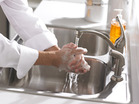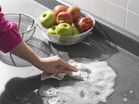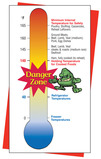Eating Safely
Keep Food Safe
Eating safely means making sure the food you consume is properly handled, prepared, and stored. It also means knowing when not to eat certain foods. Many older adults are used to cooking for themselves, while others, such as recent widowers, may have little cooking experience. It is important for anyone who handles food or cooks their own meals to know how to keep food safe and avoid foodborne illness.
How to Handle Foods Safely
Take these simple steps to avoid foodborne illnesses when handling and preparing food.
- Wash your hands with soap and water before and after handling food.
- Wash cooking items and counter tops frequently during food preparation.
- Know what foods to wash.
- Thaw foods properly.
- Cook foods to proper temperatures.
- Store foods properly.
- Avoid the "Danger Zone".
- Separate some foods.
- Avoid some foods entirely.
- Pay attention to expiration dates.
Wash Your Hands
Whether at home or away from home, be sure to wash your hands with soap and warm water before and after handling food and after using the bathroom, changing diapers, handling pets, coughing or sneezing, tending to the sick or injured, and handling garbage Hand washing is especially important after handling raw meat, poultry, seafood, and eggs.
To wash your hands, wet them, apply soap, and rub them together vigorously for at least 20 seconds. Rinse your hands under clean, running, warm water. Dry your hands completely with a clean paper towel or cloth towel.
Wash Cooking Items and Areas
Wash cutting boards, dishes, utensils, and counter tops with hot, soapy water after preparing each food item and before you go on to the next food. Also, use hot, soapy water to clean up spills in the refrigerator. Some bacteria can still grow slowly at refrigerator temperatures.
Know What Foods to Wash
Be sure to rinse fresh fruits and vegetables under running tap water, including those with skins and rinds that are not eaten. Do not use soap or bleach.
Unlike fruits and vegetables, raw meats, poultry and seafood should not be washed. Washing these raw foods might get rid of some bacteria but can increase the chance of spreading bacteria to other foods, surfaces, and utensils. Cooking these foods to a safe internal temperature will destroy any bacteria on the food.
Thaw Foods Properly
If you plan to use frozen foods, thaw them properly. Don't put frozen foods on the counter to thaw at room temperature. Instead, put the food in the refrigerator. Keep the juices from thawing meats and poultry from dripping onto other foods by putting them in containers or on a plate. Raw juices may contain harmful bacteria.
For faster thawing, put the frozen food in a leak-proof plastic bag and immerse it in cold water. Change the water every 30 minutes, and cook the food immediately after thawing. You can also thaw food in a microwave if you plan to cook it right away.
Cook Foods to Proper Temperatures
Meat and poultry need to be cooked to certain temperatures to kill harmful bacteria. Cook these foods to the following safe minimum internal temperatures before removing them from the heat source. Use a food thermometer to check the internal temperature of the food.
- All raw beef, pork, veal, and lamb steaks, roasts, and chops should be cooked to 145 degrees Fahrenheit.
- All raw ground beef, veal, pork and lamb should be cooked to 160 degrees Fahrenheit.
- All poultry, including ground poultry, should reach a minimum internal temperature of 165 degrees Fahrenheit.
If you prefer, you may choose to cook meat to higher temperatures.
Seafood and eggs need to be cooked to certain temperatures to kill harmful bacteria. Cook these foods to the following safe minimum internal temperatures.
- Seafood should be cooked to 145 degrees Fahrenheit.
- Egg dishes should be cooked to 160 degrees Fahrenheit. Eggs should be cooked until the yolk and white are firm.
- Leftovers should be reheated to 165 degrees Fahrenheit.
Use a food thermometer to check the internal temperature of the food.
Store Foods Properly
It is important to store foods properly. You should refrigerate eggs and refrigerate or freeze meat, poultry, and seafood. Never let these foods, or cut fresh vegetables or fruit, sit at room temperatures for more than two hours before storing in the refrigerator or freezer. If the temperature in the room is 90 degrees Fahrenheit or above, you should put the food away before one hour.
Avoid the "Danger Zone"
Most foods are safe after cooking to a safe internal temperature and refrigerating promptly. Keep cold foods cold and hot foods hot. Bacteria grow quickly in the "danger zone" between 40 degrees and 140 degrees Fahrenheit.
When keeping food hot for serving, it should be kept at an internal temperature of 140 degrees Fahrenheit or higher. Just keeping food warm (40 to140 degrees Fahrenheit) is not safe enough. Use a food thermometer to monitor the internal temperature of the food. If you plan to eat at a later time, you should divide the food into smaller portions or pieces, place it in shallow containers, and refrigerate it.
To keep cold foods cold, set your refrigerator at 40 degrees Fahrenheit or below and your freezer at 0 degrees Fahrenheit or below. Use an appliance thermometer to check the temperatures.
Don't keep refrigerated leftovers more than 3 to 4 days. Even if the food looks and smells fine, it may not be safe to eat after that time. If you question the safety of any food, throw it out without tasting it.
Separate Some Foods
Be sure to separate different types of foods while shopping and when preparing or storing them. When handling raw meat, poultry, seafood, and eggs, keep these foods and their juices away from ready-to-eat foods. Use one cutting board for fresh fruits and vegetables and a separate one for raw meat, poultry, seafood, and eggs. Don't place cooked food on a plate that held raw meat, poultry, seafood, or eggs unless you first wash the plate with hot, soapy water.
Avoid These Foods
Avoid these foods to reduce your chance of getting foodborne illness.
- raw or undercooked meat, poultry, fish, or seafood
- unpasteurized (raw) dairy products, and juices. Some soft cheeses such as feta, queso blanco, queso fresco, Brie, and Camembert are made with unpasteurized milk.
- raw or partially cooked eggs and foods commonly made with raw eggs such as raw cookie dough and cake batter, eggnog, and Caesar salad dressing
- hot dogs and luncheon meats, unless they are reheated until steaming hot or 165 degrees Fahrenheit
- soft cheeses like Brie and Camembert, unless labeled "made with pasteurized milk". Pasteurized food has been heated to high enough temperatures to destroy disease-causing organisms.
- uncooked sprouts, such as bean, alfalfa, clover, or radish sprouts.
- ready-to-eat meat or seafood salads.
Pay Attention to Expiration Dates
Pay attention to "sell-by" and "use-by" dates on packages and cartons.
- A "Sell-By" date tells the store how long to display the product for sale. Don't buy an item after the "sell by" date.
- A "Best if Used By (or Before)" date is the last date that the manufacturer of the product suggests is best for consuming the food.
- A "Use-By" tells how long the product will be at peak quality. If you buy or use it after that date, it might not be safe.









